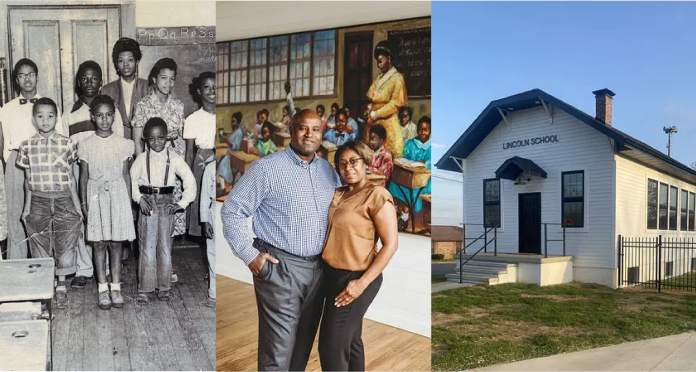West Plains, MO – Hope, resilience, and inclusiveness are powerful forces. The ability to dream of something better, to restore what was nearly lost, and to unite a community through history is a remarkable feat.
For Crockett W. Oaks Jr. III, that dream was personal.
A Dream Rooted in History
Oaks grew up in West Plains but spent three decades serving in leadership roles across the military, law enforcement, corporate security, and higher education. Yet, no matter how far he went, the pull of home remained strong. When he finally returned, he was met with a heartbreaking sight—the deteriorating remains of Lincoln School, a once-vibrant symbol of Black education and perseverance.
Built in 1926, Lincoln School was a one-room schoolhouse for Black students. Oaks’ father and aunts attended the school until its closure in 1954, following the landmark Brown v. Board of Education ruling that ended segregation in public schools. Over the years, the building was repurposed for various community services, but without preservation efforts, it fell into severe disrepair.
For Oaks, the school wasn’t just bricks and mortar—it was a testament to the strength of those who came before him.
“My parents emphasized service, history, and the importance of standing for something greater than oneself,” he said. “That foundation led me to co-found the Lincoln School Project with my wife, Tonya, as a way to preserve a vital piece of our shared history while creating new opportunities for education, dialogue, and cultural appreciation.”
A Labor of Love
Determined to honor the past and uplift his community, Oaks and his wife purchased Lincoln School from the city and embarked on a $230,000 restoration project. In January 2024, the school was reborn—not just as a historic site, but as a living tribute to resilience and heritage.
The restoration was deeply personal. The building now houses powerful murals, stained-glass windows, and historical artifacts that tell its story. One stained-glass window depicts a young Crockett Oaks standing in front of the school, while a mural captures a classroom in session, featuring his father among the students. It’s a poignant image—a father watching over his son as he revives their shared history.
More Than a School—A Community Hub
Though Lincoln School was originally built during segregation, its impact now transcends race and background. The Lincoln School Project serves as a bridge between the past and the future, bringing people together through education and cultural appreciation.
“Our goal is to ensure that history is not just remembered but actively used to inspire progress,” Oaks explained. “The Lincoln School Project isn’t just about preserving the past—it’s about empowering future generations. Through educational events, speaker series, and community gatherings, we’re creating a space that celebrates resilience, creativity, and cultural heritage.”
The project has already drawn diverse audiences and sparked meaningful conversations about history, unity, and social progress.
Oaks hopes Lincoln School will serve as a model for other communities, proving that even a small town can make a big impact when people come together with a shared vision.
A Father’s Legacy
When asked who he credits for shaping his vision, Oaks’ answer was immediate.
“Without a doubt, my father,” he said. “He has been a living archive of our community’s history, passing down stories of the Black experience in West Plains, including the role Lincoln School played in shaping lives. His wisdom, storytelling, and firsthand accounts have been invaluable in shaping my appreciation for this project.
“His influence reminds me that history isn’t just about buildings—it’s about the people whose lives were shaped within them. Because of him, these stories will not be forgotten.”
A Vision Turned Reality
Crockett and Tonya Oaks had a dream—to save history and give back to their community. Their journey wasn’t easy, but they turned their vision into reality.
Today, Lincoln School is alive once more, hosting educational events, cultural programs, and celebrations of history. A once-forgotten landmark is now a place of joy, learning, and renewed purpose.
Their story serves as a reminder to us all: If you have a dream, chase it. Push through setbacks, ignore the doubters, and believe in yourself. Every great achievement in history started with a vision—just like the Lincoln School Project.
Honoring Black History Month
Each February, Black History Month celebrates the profound contributions of African Americans to the United States. Established by historian Carter G. Woodson and the NAACP, it began as Black History Week before expanding into a full month in 1976. February was chosen to align with the birthdays of President Abraham Lincoln (Feb. 12) and Frederick Douglass (Feb. 14).
This month honors countless pioneers, including:
- Dr. Martin Luther King Jr., whose dream of racial equality inspired a movement.
- Rosa Parks, whose quiet courage sparked a revolution.
- Harriet Tubman, who led over 70 enslaved individuals to freedom through the Underground Railroad.
- Thurgood Marshall, the first Black Supreme Court justice, who played a pivotal role in the civil rights movement.
Their legacies, like the story of Lincoln School, serve as powerful reminders of the impact one dream can have on generations to come.









